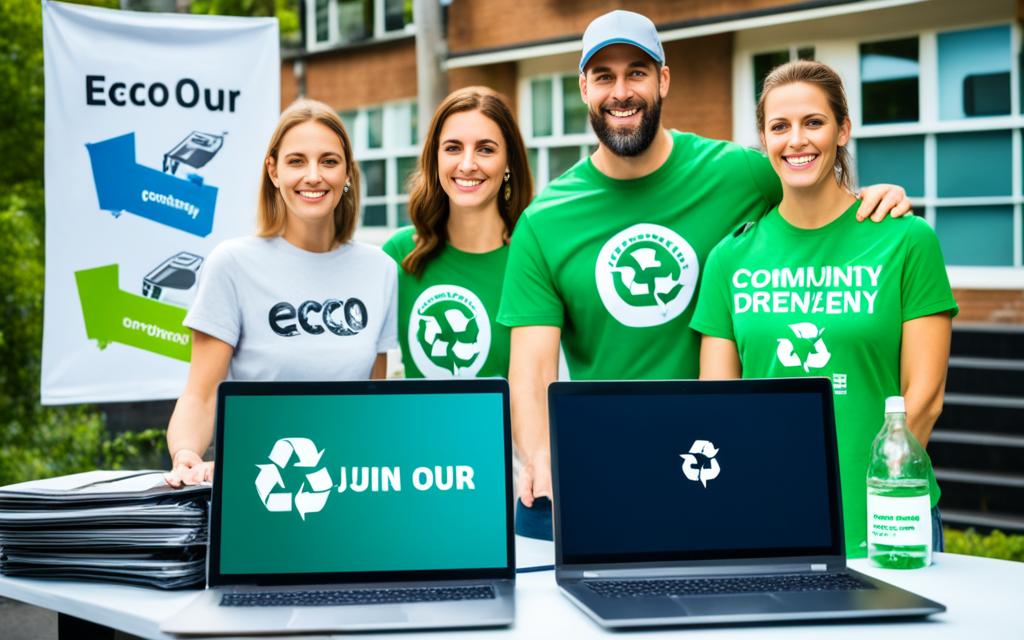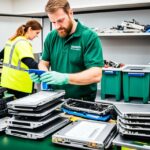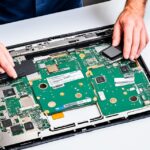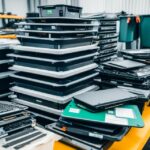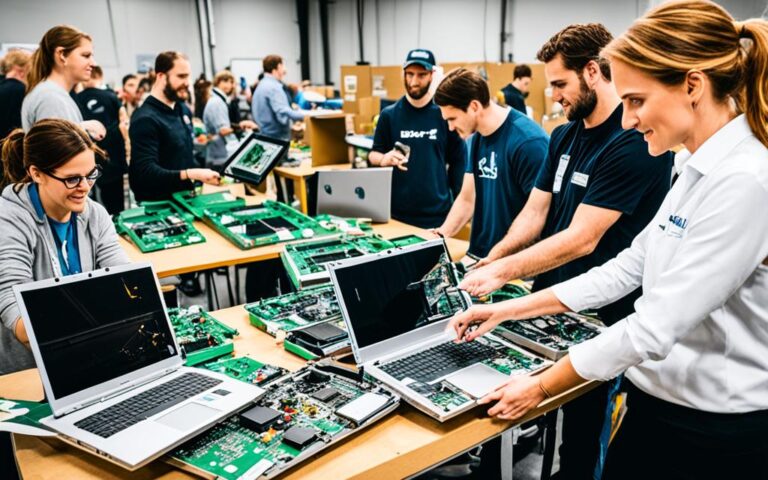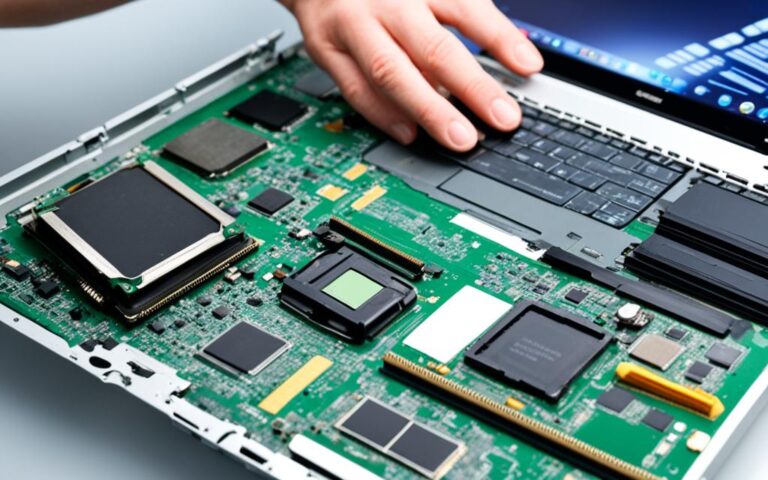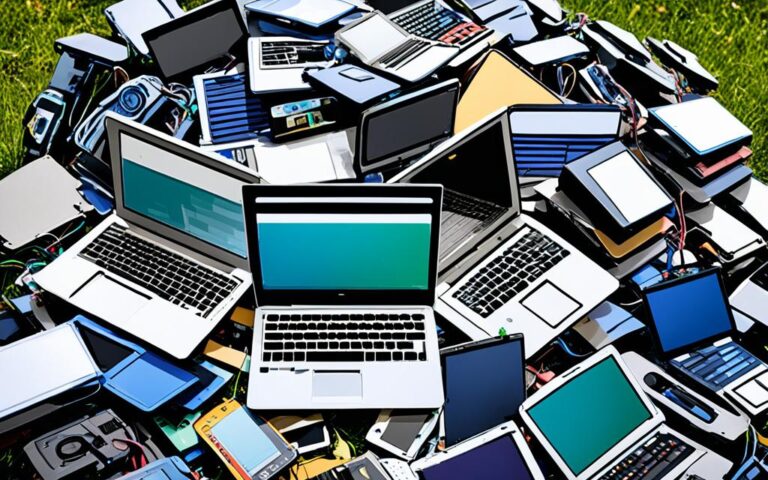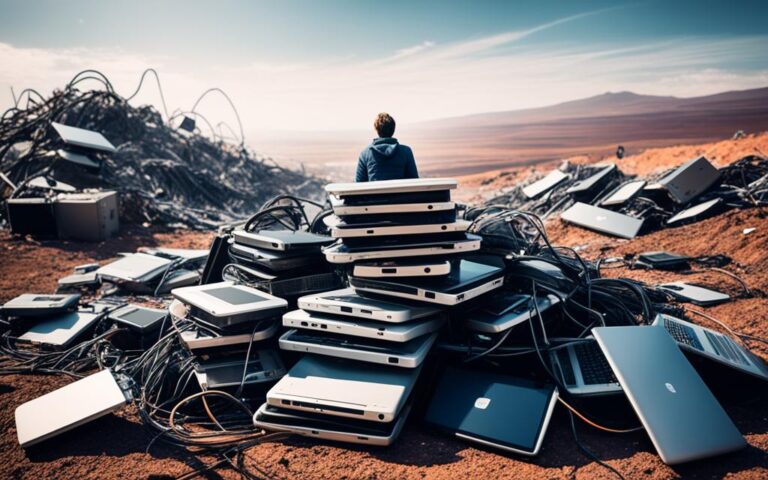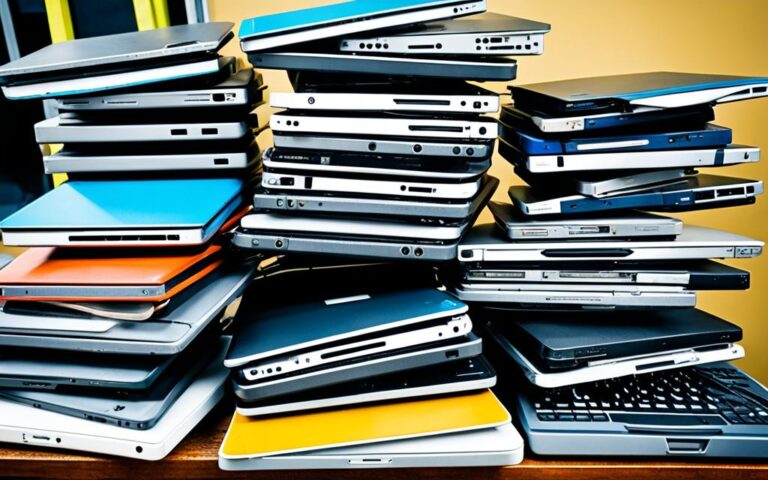How to Organize a Community Laptop Recycling Drive
Organising a laptop recycling drive in your community is a great way to promote sustainability and responsible e-waste disposal. By following these steps, you can ensure a successful event that encourages individuals to recycle their old laptops and other electronic devices.
First, you need to identify certified e-waste recyclers in your area and determine what types of electronic waste they accept. You may also want to collect other items such as light bulbs or batteries that might not be accepted by the same recycler.
Then, secure a location and date for the drive, such as a school parking lot, and obtain permission from the relevant authorities. Next, build a team to help with the logistics of the event, including drivers and volunteers for heavy lifting.
Promote the drive through flyers, posters, emails, and social media, making sure to highlight the accepted materials and any restrictions. On the day of the drive, set up signs and cones to direct cars and have a list of accepted items on hand.
Finally, deliver the collected e-waste to a certified recycler for proper disposal. Organising a laptop recycling drive is not only beneficial for the environment but also creates a sense of community and responsibility towards electronic waste disposal.
By taking the initiative to recycle laptops and other electronic devices, you can contribute to the overall sustainability of your community and the planet. Join us in making a positive impact today!
Why Recycling is Important for the Community
Recycling plays a crucial role in creating a sustainable community. It helps reduce the amount of waste sent to landfills, conserves natural resources, and reduces pollution. In the case of laptop recycling, it allows for the recovery of valuable materials like metals and plastics that can be reused in the production of new electronic devices. By organizing a laptop recycling drive, you are not only promoting responsible e-waste disposal but also raising awareness about the environmental benefits of recycling. Recycling also has economic benefits, as it creates jobs in the recycling industry and reduces the need for raw material extraction. Additionally, recycling helps mitigate climate change by reducing greenhouse gas emissions associated with the production of new materials. By recycling laptops and other electronic devices, the community can contribute to a more sustainable future.
Finding Recycling Locations and Partnering with Schools
In order to organize a successful laptop recycling drive, it is essential to find appropriate recycling locations and consider partnering with local schools. By locating certified e-waste recyclers and collaborating with educational institutions, you can maximize the impact of your recycling efforts and engage the community in a meaningful way.
Start by researching recycling locations in your area that accept large donations of electronic waste. Look for certified e-waste recyclers who adhere to responsible recycling practices. It is important to determine the types of electronic waste they accept, as well as any additional items such as light bulbs or batteries that may be collected separately.
In addition to recycling locations, consider partnering with local schools to host your laptop recycling drive. Schools often have parking lots that can serve as convenient and visible locations for community events. Reach out to teachers or principals to seek permission and discuss the logistics of using their facilities. By collaborating with schools, you can leverage their existing community networks and increase participation in the drive.
Benefits of Partnering with Schools:
- Access to a large pool of potential donors within the school community.
- Opportunity to educate students about the importance of responsible e-waste disposal.
- Increased visibility and awareness of the recycling drive among students, parents, and faculty.
- Potential for ongoing partnerships with schools for future sustainability initiatives.
By finding recycling locations and partnering with schools, you can effectively establish the groundwork for a successful laptop recycling drive. The combination of accessible drop-off points and collaboration with educational institutions will enhance community involvement and promote responsible e-waste disposal.
Building a Team and Promoting the Drive
To ensure the success of your laptop recycling drive, it’s important to build a team that will help with various tasks. The number of team members you need will depend on the scale of your event and how much you plan to advertise. At a minimum, you will need a driver and at least one van or truck to transport the collected e-waste to the recycler. Be prepared to do some heavy lifting, as electronic devices can be heavy.
Once you have your team in place, it’s time to promote the drive. Create flyers, posters, banners, and emails to advertise the event. Include the time, date, and materials you are collecting, making sure to mention any items that cannot be accepted. Hang posters and banners three weeks prior to the event, hand out flyers two weeks before, and send email reminders and social media posts throughout the final week leading up to the drive.
By promoting the drive effectively, you can raise awareness and encourage community members to participate in the laptop recycling drive.
| Team Tasks | Promotion Methods |
|---|---|
| Driver | – Create flyers with relevant information |
| Van/Truck Driver | – Design posters to hang in the community |
| Volunteers | – Make banners to display in prominent areas |
| – Send emails to community members | |
| – Utilize social media platforms for promotion |
Organizing the Drive and Collection Process
On the day of the laptop recycling drive, it’s crucial to have a well-organized collection process to ensure efficiency and accuracy. Follow these steps to ensure a smooth drive:
- Hang signs and use cones to direct cars where to pull up and drop off their items.
- Have a readily available list of accepted materials to facilitate collection.
- Take photos of the event for future promotions and to keep a record of the drive’s impact.
- Properly store and secure all collected e-waste until it can be delivered to a certified recycler.
- Consider using designated containers or boxes for different types of electronic devices to ensure safe handling.
Remember, handling the collected e-waste with care is essential to prevent any damage or data breaches.
“Our laptop recycling drive was a great success! With well-organized collection processes and attention to detail, we were able to collect a significant amount of e-waste for proper disposal. The positive impact on our environment is immeasurable.”
| Benefits of Organized Collection | Collection Process |
|---|---|
| Efficient and accurate collection | Hang signs and use cones |
| Record of the drive’s impact | Take photos of the event |
| Safe handling of collected e-waste | Use designated containers or boxes |
Connecting with Recycling Partners and Community Organizations
Building partnerships with recycling partners and community organizations is crucial for maximizing the impact of your laptop recycling drive. By collaborating with local recycling companies or e-waste recyclers, you can establish valuable relationships that offer support, resources, and even free pickup services for the collected e-waste.
To expand the reach of your drive and leverage the strength of community networks, consider connecting with organizations that share similar sustainability goals. These community organizations can play a pivotal role in promoting the drive, providing volunteers, and offering resources for proper e-waste disposal.
By forging partnerships with recycling partners and community organizations, you can create a strong network of support that extends beyond the laptop recycling drive. This network will lay the groundwork for future recycling initiatives and contribute to a more sustainable community.
Long-Term Benefits and Importance of Responsible E-Waste Disposal
Responsible e-waste disposal, such as organizing a laptop recycling drive, offers several long-term benefits for both the community and the environment. By properly disposing of old laptops and electronic devices, valuable materials can be recovered and reused, reducing the need for raw material extraction. This helps conserve natural resources and reduces the environmental impact associated with mining and manufacturing new electronics.
Additionally, proper e-waste disposal prevents hazardous materials from ending up in landfills, where they can leach into soil and water sources. By actively promoting responsible e-waste disposal, communities can contribute to a circular economy and create a more sustainable future.
“Responsible e-waste disposal is not just about protecting the environment, but also about safeguarding human health and conserving valuable resources. It’s a proactive approach that benefits both current and future generations.” – Dr. Emma Brown, Environmental Scientist
Recycling electronic waste not only reduces the strain on our planet’s resources but also minimizes the release of harmful substances into the environment. Old laptops and electronic devices contain toxic materials such as lead, mercury, and brominated flame retardants that can pose serious health risks if not properly disposed of. By ensuring responsible e-waste disposal, communities can protect their residents and contribute to a cleaner and safer environment.
The Circular Economy: Closing the Loop
A key concept in responsible e-waste disposal is the idea of a circular economy. In a linear economy, products are produced, used, and then discarded as waste. In contrast, a circular economy aims to prolong the lifespan of products through recycling and reusing, reducing the need for new production.
By recycling old laptops and electronic devices, valuable materials such as precious metals, plastics, and glass can be extracted and used as raw materials in the manufacturing of new products. This reduces the demand for virgin resources, conserves energy, and minimizes the environmental impact of production processes. Recycling also creates new job opportunities in the recycling industry, further benefiting local economies.
The Economic and Social Impact
Responsible e-waste disposal not only has environmental benefits but also significant economic and social impacts. It contributes to job creation and economic growth in the recycling and refurbishment sectors. By organizing a laptop recycling drive, communities can support local businesses specializing in e-waste management and recycling, providing employment opportunities and fostering economic development.
In addition, responsible e-waste disposal helps bridge the digital divide by making refurbished electronic devices accessible to individuals and communities who may not have the means to purchase new ones. By refurbishing and redistributing functional devices, communities can empower individuals, enhance educational opportunities, and bridge the technological gap.
| Benefit | Explanation |
|---|---|
| Conservation of Resources | Proper e-waste disposal reduces the need for raw material extraction, conserving natural resources. |
| Environmental Protection | Prevents hazardous materials from polluting the environment, protecting ecosystems and human health. |
| Circular Economy | Supports the transition to a circular economy by recycling and reusing valuable materials. |
| Job Creation | Contributes to the growth of the recycling and refurbishment sectors, creating employment opportunities. |
| Social Equality | Provides access to affordable electronic devices, bridging the digital divide and enhancing educational opportunities. |
Conclusion
Organizing a laptop recycling drive in your community is a proactive step towards promoting sustainability and responsible e-waste disposal. By following the steps outlined in this article, you can ensure a successful event that raises awareness about the importance of recycling electronic devices.
The benefits of laptop recycling go beyond environmental impact. By participating in a laptop recycling drive, you are not only helping to protect the environment but also contributing to job creation, resource conservation, and reductions in greenhouse gas emissions.
To make a significant difference in e-waste management, it’s important to involve the community, partner with schools and recycling companies, and promote the drive effectively. Together, we can build a more sustainable future and contribute to a healthier planet.
Remember to visit the IT-Recycle website for more resources on laptop recycling in the UK.
FAQ
Why should I organize a laptop recycling drive in my community?
Organizing a laptop recycling drive in your community is a great way to promote sustainability and responsible e-waste disposal. It helps reduce waste sent to landfills, conserves natural resources, reduces pollution, and allows for the recovery of valuable materials like metals and plastics.
How do I find certified e-waste recyclers in my area?
To find certified e-waste recyclers in your area, you can search online or contact your local waste management or environmental agency. They can provide you with a list of recyclers and information on what types of electronic waste they accept.
Can I collect other items like light bulbs or batteries during the laptop recycling drive?
Yes, you can collect other items like light bulbs or batteries during the laptop recycling drive. However, it’s important to determine if the same recycler accepts these additional items or if you need to find a separate recycler for them.
How do I secure a location for the laptop recycling drive?
You can secure a location for the laptop recycling drive by reaching out to local schools or community centers. Many schools are open to using their parking lots as locations for community events. Contact a teacher or the principal to seek permission and discuss logistics.
How can I promote the laptop recycling drive?
You can promote the laptop recycling drive through flyers, posters, emails, and social media. Highlight the accepted materials and any restrictions. Hang posters and banners, hand out flyers, and send email reminders and social media posts leading up to the drive.
What should I do on the day of the laptop recycling drive?
On the day of the laptop recycling drive, set up signs and cones to direct cars. Have a list of accepted materials readily available. Take photos of the event for future promotions and ensure collected e-waste is properly stored and secured until it can be delivered to a certified recycler.
How can I build partnerships with recycling partners and community organizations?
You can build partnerships with recycling partners and community organizations by reaching out to local recycling companies or e-waste recyclers. They may provide support, resources, or free pickup services. Connect with community organizations that share similar sustainability goals and can help promote the drive or provide volunteers.
What are some long-term benefits of responsible e-waste disposal?
Responsible e-waste disposal, like organizing a laptop recycling drive, helps conserve natural resources, reduces the environmental impact of mining and manufacturing new electronics, prevents hazardous materials from ending up in landfills, and contributes to a circular economy.
How can I make a significant difference in e-waste management through a laptop recycling drive?
By involving the community, partnering with schools and recycling companies, promoting the drive effectively, and properly disposing of collected e-waste, you can make a significant difference in e-waste management. Together, we can build a more sustainable future and contribute to a healthier planet.

